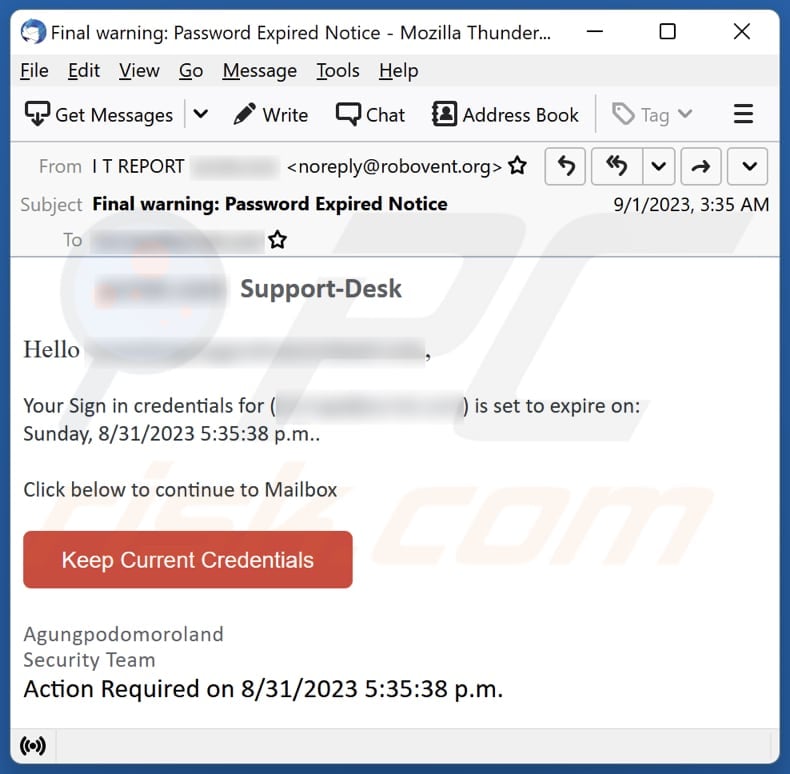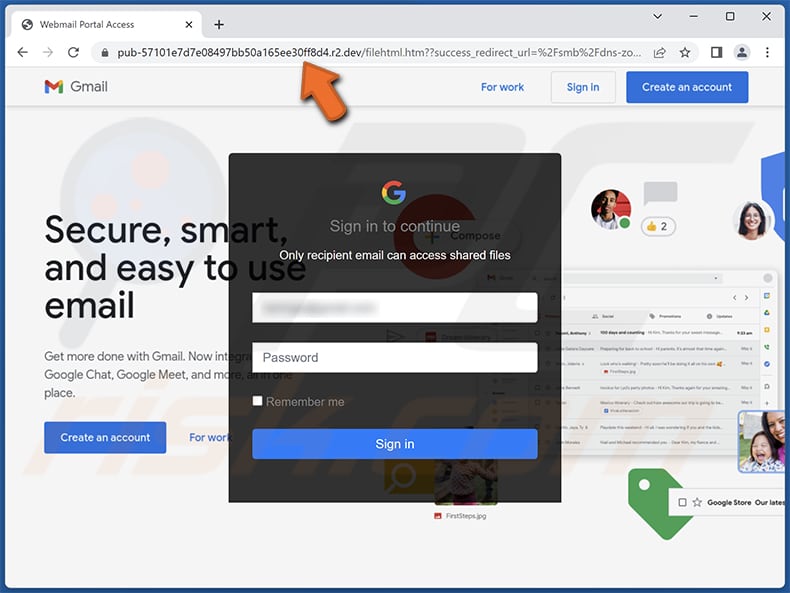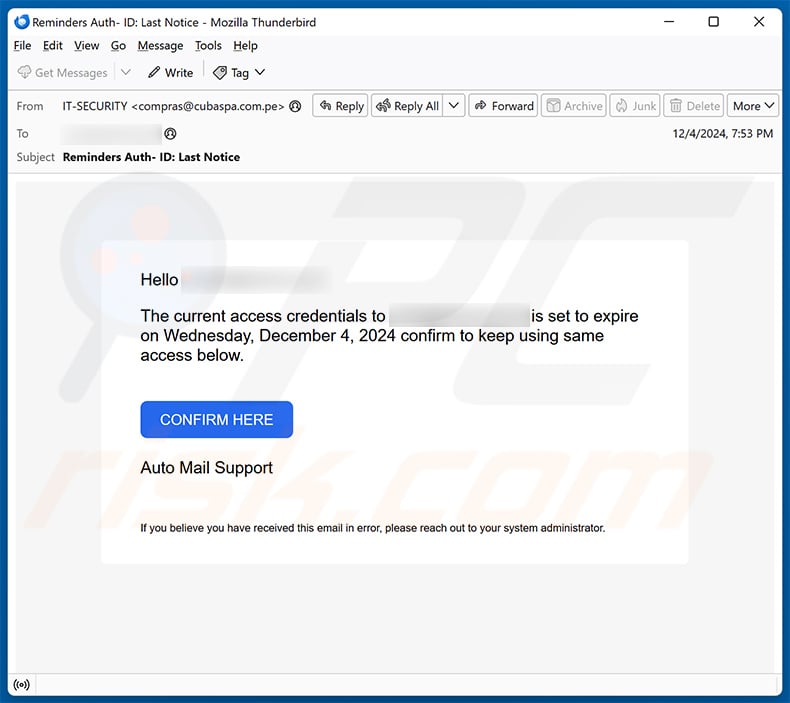How to spot scams like "Sign In Credentials Is Set To Expire"
Phishing/ScamAlso Known As: Sign In Credentials Is Set To Expire phishing campaign
Get free scan and check if your device is infected.
Remove it nowTo use full-featured product, you have to purchase a license for Combo Cleaner. Seven days free trial available. Combo Cleaner is owned and operated by RCS LT, the parent company of PCRisk.com.
What is "Sign In Credentials Is Set To Expire"?
After a comprehensive review, our team has determined that the intention behind this email is to deceive recipients into disclosing their personal information. These emails are categorized as phishing attempts, and in this specific case, the scammers pose as an email service provider with the aim of tricking recipients into revealing sensitive data on a phishing page.

More about the "Sign In Credentials Is Set To Expire" scam email
The phishing email claims to be a "final warning" about an expired password and is sent by "Support-Desk". It tells recipients that their login details will expire on a specified date and time. The email urges them to click a link labeled "Keep Current Credentials".
When the recipient clicks on the "Keep Current Credentials" link, it leads to a counterfeit page that mimics a sign-in page tailored to match the recipient's email service. For example, if the recipient uses the Gmail email service, the phishing page will pretend to be a Gmail sign-in page.
Scammers behind this phishing page and email aim to deceive users into disclosing their email account login credentials. Scammers can use the compromised email account to send convincing phishing emails to the victim's contacts. These emails may include malicious links or attachments to trick others into revealing their personal information or spreading malware.
Stolen email credentials can provide scammers access to sensitive personal information, allowing them to commit identity theft. If the compromised email account is linked to other online accounts, scammers can attempt to gain access to those accounts, potentially compromising additional sensitive data, such as bank accounts or social media profiles.
Scammers may use the stolen email credentials to attempt login to various online services, hoping that the victim uses the same username and password combination for multiple accounts. This can result in further security breaches. Thus, it is important to be cautious when dealing with suspicious emails.
| Name | Sign In Credentials Is Set To Expire Email Scam |
| Threat Type | Phishing, Scam, Social Engineering, Fraud |
| Fake Claim | Email account login credentials will expire on the specified date and time |
| Disguise | Letter from an email service provider |
| Symptoms | Unauthorized online purchases, changed online account passwords, identity theft, illegal access of the computer. |
| Distribution methods | Deceptive emails, rogue online pop-up ads, search engine poisoning techniques, misspelled domains. |
| Damage | Loss of sensitive private information, monetary loss, identity theft. |
| Malware Removal (Windows) |
To eliminate possible malware infections, scan your computer with legitimate antivirus software. Our security researchers recommend using Combo Cleaner. Download Combo CleanerTo use full-featured product, you have to purchase a license for Combo Cleaner. 7 days free trial available. Combo Cleaner is owned and operated by RCS LT, the parent company of PCRisk.com. |
Similar scam emails in general
Phishing emails are deceptive messages sent by cybercriminals to trick recipients into revealing personal information, such as login credentials or financial details. These emails often appear legitimate and may contain fake links or attachments that lead to malicious websites or malware downloads.
It is essential to exercise caution and verify the authenticity of email messages to avoid falling victim to phishing scams. More examples of phishing emails are "Nehmeh Purchase Order", "Adobe PDF Shared", and "Incoming Messages Were Not Delivered".
How do spam campaigns infect computers?
Users can accidentally put their computers at risk when they interact with attachments or links in fake emails. These emails often contain harmful attachments like PDFs, Microsoft Office files (such as Word or Excel), JavaScript files, executable files with .exe extensions, or compressed archive files like ZIP or RAR.
When users open such attachments or click on the provided links, they can unintentionally initiate the download and execution of malicious software, such as ransomware or trojans. Cybercriminals frequently employ manipulative tactics in emails to persuade users to perform these risky actions.
How to avoid installation of malware?
Be careful with emails from unknown or questionable sources, especially if they have unexpected attachments or links. Only get software and files from trusted sources, such as official web pages or stores. Avoid risky websites, unofficial app stores, peer-to-peer (P2P) networks, etc., because they often are used to distribute harmful software.
Install reliable antivirus or anti-malware software on your computer. Make sure to keep your operating system, software, and antivirus program up to date. Exercise caution when clicking on ads, pop-ups, or links on suspicious websites.
If you've already opened malicious attachments, we recommend running a scan with Combo Cleaner Antivirus for Windows to automatically eliminate infiltrated malware.
Text presented in the "Sign In Credentials Is Set To Expire" email letter:
Subject: Final warning: Password Expired Notice
******** Support-Desk
Hello ********,
Your Sign in credentials for (********) is set to expire on:
Sunday, 8/31/2023 5:35:38 p.m..Click below to continue to Mailbox
Keep Current Credentials
Agungpodomoroland
Security Team
Action Required on 8/31/2023 5:35:38 p.m.
Screenshot of the phishing website:

Another example of an email from "Sign In Credentials Is Set To Expire" spam campaign:

Text presented within:
Subject: Reminders Auth- ID: Last Notice
Hello ********,
The current access credentials to ******** is set to expire on Wednesday, December 4, 2024 confirm to keep using same access below.
CONFIRM HERE
Auto Mail Support
Instant automatic malware removal:
Manual threat removal might be a lengthy and complicated process that requires advanced IT skills. Combo Cleaner is a professional automatic malware removal tool that is recommended to get rid of malware. Download it by clicking the button below:
DOWNLOAD Combo CleanerBy downloading any software listed on this website you agree to our Privacy Policy and Terms of Use. To use full-featured product, you have to purchase a license for Combo Cleaner. 7 days free trial available. Combo Cleaner is owned and operated by RCS LT, the parent company of PCRisk.com.
Quick menu:
- What is Sign In Credentials Is Set To Expire phishing campaign?
- Types of malicious emails.
- How to spot a malicious email?
- What to do if you fell for an email scam?
Types of malicious emails:
![]() Phishing Emails
Phishing Emails
Most commonly, cybercriminals use deceptive emails to trick Internet users into giving away their sensitive private information, for example, login information for various online services, email accounts, or online banking information.
Such attacks are called phishing. In a phishing attack, cybercriminals usually send an email message with some popular service logo (for example, Microsoft, DHL, Amazon, Netflix), create urgency (wrong shipping address, expired password, etc.), and place a link which they hope their potential victims will click on.
After clicking the link presented in such email message, victims are redirected to a fake website that looks identical or extremely similar to the original one. Victims are then asked to enter their password, credit card details, or some other information that gets stolen by cybercriminals.
![]() Emails with Malicious Attachments
Emails with Malicious Attachments
Another popular attack vector is email spam with malicious attachments that infect users' computers with malware. Malicious attachments usually carry trojans that are capable of stealing passwords, banking information, and other sensitive information.
In such attacks, cybercriminals' main goal is to trick their potential victims into opening an infected email attachment. To achieve this goal, email messages usually talk about recently received invoices, faxes, or voice messages.
If a potential victim falls for the lure and opens the attachment, their computers get infected, and cybercriminals can collect a lot of sensitive information.
While it's a more complicated method to steal personal information (spam filters and antivirus programs usually detect such attempts), if successful, cybercriminals can get a much wider array of data and can collect information for a long period of time.
![]() Sextortion Emails
Sextortion Emails
This is a type of phishing. In this case, users receive an email claiming that a cybercriminal could access the webcam of the potential victim and has a video recording of one's masturbation.
To get rid of the video, victims are asked to pay a ransom (usually using Bitcoin or another cryptocurrency). Nevertheless, all of these claims are false - users who receive such emails should ignore and delete them.
How to spot a malicious email?
While cyber criminals try to make their lure emails look trustworthy, here are some things that you should look for when trying to spot a phishing email:
- Check the sender's ("from") email address: Hover your mouse over the "from" address and check if it's legitimate. For example, if you received an email from Microsoft, be sure to check if the email address is @microsoft.com and not something suspicious like @m1crosoft.com, @microsfot.com, @account-security-noreply.com, etc.
- Check for generic greetings: If the greeting in the email is "Dear user", "Dear @youremail.com", "Dear valued customer", this should raise suspiciousness. Most commonly, companies call you by your name. Lack of this information could signal a phishing attempt.
- Check the links in the email: Hover your mouse over the link presented in the email, if the link that appears seems suspicious, don't click it. For example, if you received an email from Microsoft and the link in the email shows that it will go to firebasestorage.googleapis.com/v0... you shouldn't trust it. It's best not to click any links in the emails but to visit the company website that sent you the email in the first place.
- Don't blindly trust email attachments: Most commonly, legitimate companies will ask you to log in to their website and to view any documents there; if you received an email with an attachment, it's a good idea to scan it with an antivirus application. Infected email attachments are a common attack vector used by cybercriminals.
To minimise the risk of opening phishing and malicious emails we recommend using Combo Cleaner Antivirus for Windows.
Example of a spam email:

What to do if you fell for an email scam?
- If you clicked on a link in a phishing email and entered your password - be sure to change your password as soon as possible. Usually, cybercriminals collect stolen credentials and then sell them to other groups that use them for malicious purposes. If you change your password in a timely manner, there's a chance that criminals won't have enough time to do any damage.
- If you entered your credit card information - contact your bank as soon as possible and explain the situation. There's a good chance that you will need to cancel your compromised credit card and get a new one.
- If you see any signs of identity theft - you should immediately contact the Federal Trade Commission. This institution will collect information about your situation and create a personal recovery plan.
- If you opened a malicious attachment - your computer is probably infected, you should scan it with a reputable antivirus application. For this purpose, we recommend using Combo Cleaner Antivirus for Windows.
- Help other Internet users - report phishing emails to Anti-Phishing Working Group, FBI’s Internet Crime Complaint Center, National Fraud Information Center and U.S. Department of Justice.
Frequently Asked Questions (FAQ)
Why did I receive this email?
Scammers send the same letters to thousands of people, hoping that at least one person will fall for their tricks. These spam emails lack any personal touch or customization.
I have provided my personal information when tricked by this email, what should I do?
If you have mistakenly shared personal information (email account login credentials) on a deceptive website, act swiftly. Change your passwords, monitor your accounts for unusual activity, and consider reporting the potential security breach to the email service provider.
I have downloaded and opened a file attached to an email, is my computer infected?
Opening a harmful email attachment can put your computer at risk. Files with .exe extensions carry a greater threat, while with file types like MS Office documents, infections often occur when users enable macros commands.
I have read the email but did not open the attachment, is my computer infected?
Just opening an email by itself is safe and poses no immediate threat. The danger comes when you click on links within the email or open attached files.
Will Combo Cleaner remove malware infections that were present in email attachment?
Combo Cleaner will scan your computer and efficiently remove malware. It can detect almost all known malware. A comprehensive system scan is essential to completely remove advanced malware because these threats often hide deeply within the system.
Share:

Tomas Meskauskas
Expert security researcher, professional malware analyst
I am passionate about computer security and technology. I have an experience of over 10 years working in various companies related to computer technical issue solving and Internet security. I have been working as an author and editor for pcrisk.com since 2010. Follow me on Twitter and LinkedIn to stay informed about the latest online security threats.
PCrisk security portal is brought by a company RCS LT.
Joined forces of security researchers help educate computer users about the latest online security threats. More information about the company RCS LT.
Our malware removal guides are free. However, if you want to support us you can send us a donation.
DonatePCrisk security portal is brought by a company RCS LT.
Joined forces of security researchers help educate computer users about the latest online security threats. More information about the company RCS LT.
Our malware removal guides are free. However, if you want to support us you can send us a donation.
Donate
▼ Show Discussion